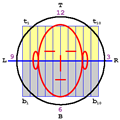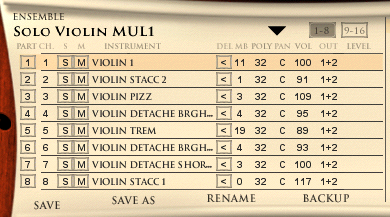- It is currently Tue Apr 16, 2024 3:17 pm • All times are UTC - 5 hours [ DST ]
Attention:
Welcome to the old forum. While it is no longer updated, there is a wealth of information here that you may search and learn from.
To partake in the current forum discussion, please visit https://forums.presonus.com
Tutorial how to use multichannel Miroslav
4 posts
• Page 1 of 1
Tutorial how to use multichannel Miroslav
Is there any video tutorial how to use multichannel Miroslav Philharmonik in Notion 4
-

carlosetmenezes - Posts: 13
- Joined: Sat May 04, 2013 3:27 pm
- Location: Avaré - SP -Brasil
Re: Tutorial how to use multichannel Miroslav
carlosetmenezes wrote:Is there any video tutorial how to use multichannel Miroslav Philharmonik in Notion 4
I made a quick video with no voice-over, and it is available to watch in 720p HD:
[NOTE: The YouTube video is available in the US, but it might take a while to get to the YouTube cloud for Brazil, although perhaps not. It might be available everywhere at the same time . . . ]
NOTION 4 32-bit Miroslav Philharmonik Multi-Channels -- YouTube video
The general procedure is documented in the following topic as a way to use a Miroslav Philharmonik (IK Multimedia) VSTi virtual instrument with multiple channels as the source for a NOTION staff to get all the notes for a Soprano Choir on one staff:
Miroslav, Female choir and musical staves. (Notion Music FORUM)
You can see how it is done in this example score, which uses NOTION 3:
[NOTE: In the following NOTION 3 score, the first four measures are "FEMALE AH STCH", which is the 1st part and channel 1, and is indicated by "MP (1)". Then at the start of the fifth measure the voices change to "FEMALE AH AMV", which is the 2nd part and channel 2. I added only five "parts" or "channels" to the MP instance, but you can add up to 16. You can open this NOTION 3 score in the 32-bit version of NOTION 4, and it should work the same . . . ]
NOTION 3 ~ Miroslav Philharmonik ~ Female Choir - Articulation Change -- NOTION 3 Score (*.notion)
You will need to run the 32-bit version of NOTION 4, since at present Miroslav Philharmonik runs only as a 32-bit VSTi virtual instrument . . .
Let me know if this is sufficient information to answer your question about how to use multiple channels in Miroslav Philharmonik on a NOTION 4 staff . . .
Lots of FUN!
-

Surfwhammy - Posts: 1137
- Joined: Thu Oct 14, 2010 4:45 am
Re: Tutorial how to use multichannel Miroslav
Thank Surfwhammy think I understand it, do some testing
-

carlosetmenezes - Posts: 13
- Joined: Sat May 04, 2013 3:27 pm
- Location: Avaré - SP -Brasil
Re: Tutorial how to use multichannel Miroslav
carlosetmenezes wrote:Thank Surfwhammy think I understand it, do some testing
Glad to help!
When you have loaded a set of instruments into an instance of Miroslav Philharmonik, you can save the set as a user-defined "COMBI". Then when you need the same set of instruments, you can just load the user-defined "COMBI" . . .

Miroslav Philharmonik ~ Solo Violin Mul1 ~ COMBI
In the sample NOTION 3 score, I changed the name of the VSTi virtual instrument from the default "Philharmonik" to "MP", which saves space. You can change the full name and the abbreviation, and they can be the same. By doing it this way, you see "MP (1)" rather than "Philharmonik (1)" when you make an explicit channel switch in the music notation for the staff, which I think is easier to read. Or you can use a more descriptive name like "MP Alto Sax" . . .
THOUGHTS
There is another more advanced way to switch channels, and it involves using rules, which are sections of XML code that key on notes and articulations. This is the way the Miroslav Philharmonik presets for NOTION are coded, and there are instructions for creating your own user-defined rules . . .
As a general principle, I think that you get the most realistic sounds when you match the sampled sound to the exact articulation, since by doing a one-to-one mapping what you hear is the digitized version of a recording of a real musician playing the real instrument in the specific articulation . . .
There are other factors that affect realism, and these are two of them:
(1) Reference Tuning Pitch: "Concert A" generally is defined to be 440-Hz, but there are other variations. "Concert A = 440-Hz" is not the default reference tuning pitch for NOTION, so if you want to use it, then you need to change it in NOTION Preferences. The way this affects realism is that if the samples were recorded when musicians were using 443-Hz as their reference tuning pitch, if you are using 440-Hz, then the pitch of the sampled sounds needs to be adjusted by an algorithm, which will involve logarithmic extrapolation, which is fine, but it changes the sampled sounds by a tiny bit, which for some articulations can be significant, where tremolo and vibrato are examples, since both of them are time-based and vibrato additionally is pitch-based . . .
(2) Chromatic or Partial Sampling: In some sampled sound libraries all the notes are not sampled, where as an exaggerated example consider (a) that A3 is sampled and C4 ("Middle C" in scientific pitch notation) are sampled but (c) that A#3 and B3 are not sampled. This is what I call "partial sampling", and what happens when you specify A#3 is that the engine needs to do a more elaborate computation to create the A#3 note, which it might do by starting with the actually sampled A3 and then doing a mathematical algorithm to increase the pitch. But in the same example, if you specify B3, the engine might use C4 as the basis and then lower it in pitch to make it sound like B3 . . .
The problem with doing it this way is that for time-based and pitch-based articulations, the resulting sound for the computed or "emulated" note is quite likely to be different when compared to the way it would sound if the note actually was sampled, which is easiest to understand when you consider tremolo for a moment, where in this context "tremolo" is defined as a fluctuation in volume over time, typically done at a fixed rate or speed, where for example the tremolo might be done at a fixed rate or speed of 120 fluctuations per minute or 2 fluctuations per second, where in each fluctuation the volume is lowered and then raised symmetrically by 50 percent, so that if the starting volume level is 100, then it drops to 50 and then returns to 100 two times each second, regardless of the pitch of the note being played . . .
When every note is sampled (which is "chromatic sampling"), the tremolo is exactly the same for every note, but when notes only are partially sampled, the non-sampled notes need to be computed, and what can happen is that when A3 arbitrarily is played faster to create the note A#3, the pitch is increased but so is the tremolo rate, hence for the emulated or artificially created notes the tremolo rate or speed will be different, depending on whether (a) a lower-pitch sampled note is used to create or emulate a higher-pitch note or (b) a higher-pitch sampled note is used to create a lower-pitch note, where (a) maps to an arbitrarily increased tremolo rate or speed, while (b) maps to an arbitrarily decreased tremolo rate or speed . . .
The differences in tremolo rates will vary by the pitch of the notes being emulated, but there are differences, as is the case with pitch-based articulations like vibrato, where "vibrato" is a time-based variation in pitch, hence there are time and pitch variables . . .
At least in theory, I think there should be a way to compensate for time-based and pitch-based variations when emulating specific notes via mathematical algorithms, but whether this happens depends on several factors and probably varies by sampled sound libraries and engines, where for reference the "engine" used for Miroslav Philharmonik is the IK Multimedia SampleTank engine, hence the guideline I use is based on determining that the most realistic sound comes from minimizing the amount of emulating the engine needs to do, which basically maps to specifying the set of sampled sounds that most precisely matches the reference tuning and articulation you want to hear, where if you are using "Concert A = 440-Hz", then you want to use a sampled sound library where the various instruments actually were tuned to 440-Hz as the reference tuning pitch; and you want the sampled sound library to be "chromatically sampled", where every note is sampled in every articulation, and so forth and so on, but the problem with chromatic sampling is that it increases the number of samples, as does the number of articulations . . .
If there are 100 notes and 1,000 articulations, then there need to be 100,000 samples for each instrument that can play 100 notes in the number of different articulations, where in this usage nearly everything is an "articulation", including dynamics, such that there is a separate set of sampled notes where the musician is playing a real instrument "forte", as is the case when the musician is playing the real instrument "pianissimo", and so forth and so on, because I suggest that there are differences which go beyond simply lowering or raising the volume level for dynamics, where on violin I think that one has to bow harder and to press the string to the fingerboard with increased pressure to play "forte" as compared to "pianissimo", and this affects the way the note sounds in what one might call a "textural" way, and so forth and so on . . .
Similarly, with vibrato I think that the extreme is to have a set of samples played at varying vibrato speeds and intensities, since vibrato is not always slow or always fast. It varies, and if you want the most realism, then you need to find a way to make the vibrato sound the way you want it to sound based on the way your imagined musicians are doing vibrato . . .
There are other factors, of course, but these are two that I think are very important to understand . . .
Lots of FUN!
-

Surfwhammy - Posts: 1137
- Joined: Thu Oct 14, 2010 4:45 am
4 posts
• Page 1 of 1
Who is online
Users browsing this forum: No registered users and 14 guests